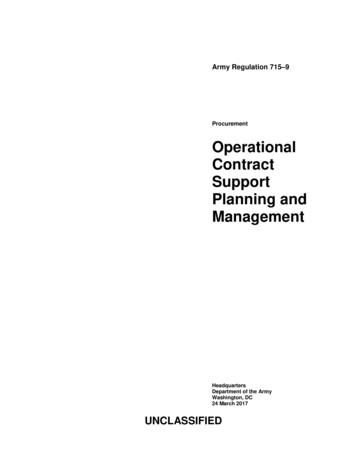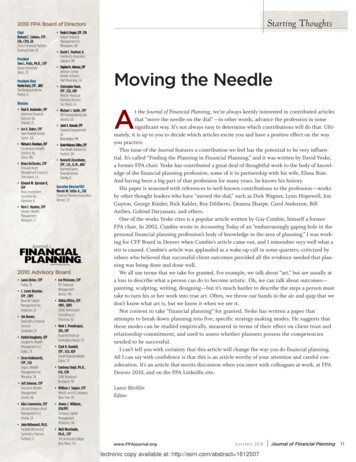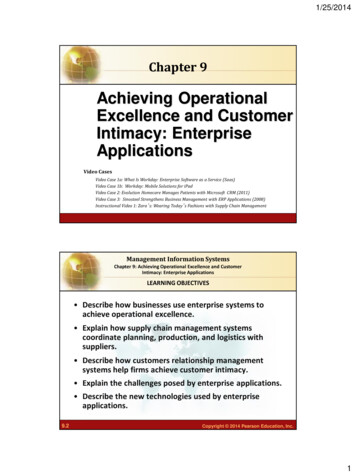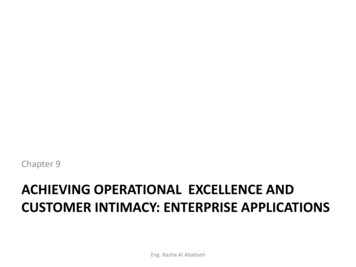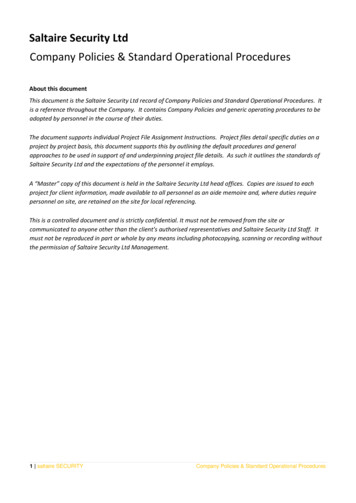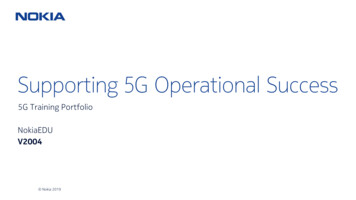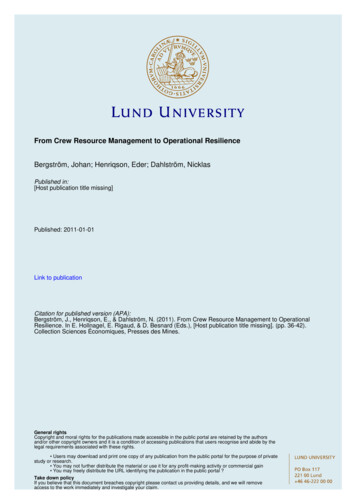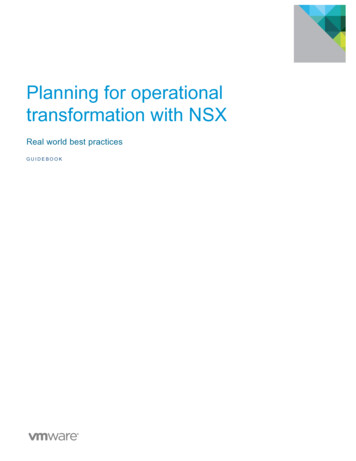
Transcription
Planning for operationaltransformation with NSXReal world best practicesGUIDEBOOK
Planning for operational transformation with NSXTable of ContentsIntroduction. 3People . 4Process . 8Technology . 12Next Steps . 16BEST PRACTICES GUIDE /2
Planning for operational transformation with NSXIntroductionThis white paper is primarily for cloud, networking, and security executives and managers. It is also helpfulfor managers and individual contributors in architecture, engineering, and operations who are participating inoperationalizing NSX at their organization.Network virtualization represents a major advancement in helping organizations realize the benefits ofspeed, agility, and security. It is equivalent to or greater than the benefits that compute virtualizationprovided over the past decade. To realize the benefits of network virtualization, organizations will want toassess and execute an operational plan that spans across people, process, and technology.VMware worked closely with existing NSX customers to understand the realities of putting networkvirtualization into production. This real-world knowledge will help guide you through the evaluation,deployment, and operationalization of NSX. You and your organization can review and make use of the bestpractices that make the most sense for your particular situation.While this paper covers a broad spectrum of best practices, NSX can be operationalized with minimalchanges to start, regardless of your current state. Operationalizing NSX is not complicated, and there’s aclear path for success.This guide is divided into three main sections that address key learnings and best practices for:PeopleNetwork virtualization offers the potential to unlock organizational strengths and majorbenefits of transforming how work gets done across the technology organization. Italso represents a change that needs to be carefully considered to ensure clarity andalignment across the organization. Ensuring you have an agile organizationalstructure, with blended teams that have clear roles and responsibilities, will allow youto derive the greatest outcomes and value for your organization and staff. We provideinformation and guidance on organizational structures, internal engagement andcommunication strategies, and roles and responsibilities.ProcessNetwork virtualization provides tremendous opportunities to increase productivitythrough the automation of manual processes across the application life cycle. Definingan ideal future state for how you provision, manage, and monitor applications andservices will allow you to move away from unnecessary existing processes andpractices. We will give you guidance on how to think about automation, processmanagement, tooling, and some interesting use cases.TechnologyOne of the main advantages of network virtualization is the decoupling of network andsecurity functions from the underlying physical network infrastructure and abstractingthem into a virtualization layer. This allows you to better architect and manage yourinfrastructure moving forward. We will provide guidance on architectural best practices,incremental implementation of infrastructure, and periodic rollout of new capabilities.These best practices are not meant to be prescriptive or “one size fits all.” You need to choose those youbelieve will work for your organization given its unique characteristics, goals, and priorities. Do not attempt aBig Bang approach. Start small with a couple or a few, then address others over time.BEST PRACTICES GUIDE /3
Planning for operational transformation with NSXSome organizations get complacent and stop short on their journey to optimal performance. As a result, theylimit the success that can be achieved for their organization. Always keep the end state in mind, andcontinually strive to improve and reach it.PeopleThe first topic we want to address is people: the organization, teams, and individualswho comprise your technology organization responsible for the end-to-end deliveryand management of apps and services and, ultimately, the driving force behind thesuccessful operationalization of network virtualization and security.Initial thoughts on organizational structureNetwork virtualization and NSX do not require a particular type of organizational structure. The optimalstructure depends on factors that are unique to your organization. NSX has been operationalized intraditionally siloed organizations to fully blended and embedded cloud teams. Midpoints also exist betweenstrictly siloed and fully blended teams.Your ideal organizational structure will depend on numerous factors. The following should be taken intoconsideration when designing the structure: Alignment among domains and disciplines Maturity of the value stream Level of technical leadership Experience and expertise of staff Operational experience and sophistication Use of outsourcing Quantity of infrastructure and applications Brownfield or greenfield deploymentOur recommendation: design a blended team structureBased on real-world experience, the most productive teams are tightly woven, highly collaborative, andself-sufficient. These blended teams are proven to work more efficiently, with shorter cycle times, withcondensed and amplified feedback loops, and with more knowledge sharing and continuous learning.Ideally the team is co-located.We have seen successful organizational structures made up of teams based on domain (e.g., compute,storage, networking, and security), and based on discipline (e.g., architecture, development and integration,operations, and support). In both cases, the teams are responsible for physical and virtual infrastructure.As you move more infrastructure and applications from your existing corporate network to your cloud, theallocation of people will also shift. Over time, more staff members will be working on the cloud and fewerworking on the existing corporate network. It is important to develop a communication and training plan tohelp the organization understand and be prepared for this evolution as well as new career opportunities.Equally as important, you will want to communicate the fact that, regardless of whether an individual isworking on the existing corporate network or the cloud, that individual’s contribution is essential to theoverall success of the organization.BEST PRACTICES GUIDE /4
Planning for operational transformation with NSXAlign with shared measures of successAn important next organizational consideration is alignment with a shared strategy that has well-definedgoals, objectives, measures, and incentives. Your team should have a service-oriented approach and becollectively responsible for the entire service delivery life cycle, from business requirements to operating andmanaging a high-quality production workload that is backed by an SLA.Each team should also have shared measures of success based on factors that matter most for yourorganization. Examples include: time to market, impact on revenue, market responsiveness, rate ofinnovation, and/or customer benefits and satisfaction. The goals should be outwardly focused on thebusiness and consumers of the service.Allow the team to develop and track its own measures of success. But ensure that measures are relevantand aligned to the shared goals and objectives. In addition to aligning to organizational goals, the keyperformance indicators should be specific, clear, quantifiable, and measurable. Whatever key performanceindicators the team chooses, they should keep it simple and start with a few basic metrics that are easy tounderstand and meaningful.After you have chosen your key performance indicators, baseline and document where you stand today.Periodically track and assess your progress (e.g., typically monthly or quarterly) in moving towards thedesired end state. Make it clear to the team that they are doing this not to criticize people or pastperformance, but to show proof of the team’s success and the new value they are delivering to the business.These measures can also be used to make performance review and evaluation more effective, tangible, andmeaningful for the individual.Creating an accountable and engaged cultureCulture is an important underpinning of success with network virtualization and security. Having a culturethat is supportive of the principles of a software-defined data center is crucial. Rather than mandate culturalchange from the executive or management level, which is fundamentally very difficult, culture should emergeorganically from within the teams through their shared experience, skills, and values.By establishing shared measures of success, a new culture will emerge and take root naturally. Thefoundation of the new culture will be based on a clear business and consumer-focused goal, sharedresponsibilities and risks, closer collaboration and cooperation, and mutual trust and respect.The team: security and networking expertise working togetherOne of the main advantages of network virtualization is the decoupling of network and security functionsfrom the underlying physical network infrastructure and abstracting them into a virtualization layer. This shifthas created some questions, such as: “Which team is responsible for virtual networking and security runningin the hypervisor?” and “How does network virtualization change my responsibilities?” In this section weanswer these questions.Your existing network and security staff take on network virtualization and security. NSX is based onnetworking concepts and technologies that require networking expertise. Only your network teams have therequired expertise. Network and security experts are needed to design, deploy, and operate virtualnetworks, just like they are with physical networks.The physical network does not go away—but it does become much simpler and easier to manage. We donot recommend creating an arbitrary team boundary along the physical and logical networks. To helpmaximize speed and agility, one team that includes network architects, engineers, and operators should beresponsible for the physical underlay and virtual overlay.You may still choose, however, to have network engineers who focus more on racking, stacking, andconfiguring the physical equipment, and others who focus more on the virtual overlay. But, all of thesepeople should be a part of the same team.BEST PRACTICES GUIDE /5
Planning for operational transformation with NSXThe networking disciplinary functions (e.g., architects, engineers, and operators) evolve to include networkvirtualization and security. Most people in networking and security will need to learn something new toenhance their expertise and skills. With NSX, network services are running in the hypervisor layer.Network professionals must have some understanding of server virtualization and what it means tological network services.People best practice: trainingEarly in the evaluation process, the highest priority is to make sure everyone understands theprinciples of network virtualization and is trained on NSX and related operations andmanagement tools that are part of the cloud ecosystem. VMware offers a number of ways todo this, including hands-on labs, workshops, and courses. These resources are primarily fornetwork professionals who don’t have a server virtualization background, but they are suitablefor server virtualization professionals who are trying to learn about network virtualization. Youcan also implement a program to ensure intra-team and inter-team knowledge sharing andtraining by providing leadership opportunities for individuals to informally teach best practicesto other teams and groups.One of the best ways to accelerate learning is to identify and start a small pilot project andevaluation. Involve all of the necessary disciplinary functions—architecture, engineering, andoperators—across compute, storage, networking, and security.Start with a small, cross-functional teamAnother low-risk recommendation is that you start with a small, cross-functional team in your progressiontoward network virtualization. If you are able to move from siloed to blended teams, do so in stages, overtime. We’ve seen mostly two types of cross-functional teams. Choose the model that works best for you:Incubation teamIf you are able to move to a blended team in thelong run, use an incubation team. Theincubation team will eventually become apermanent part of the organizationalstructure/chart. And, have full-time employeeswho spend 100% of their time with the team.Tiger teamIf you are not able to move to a blendedteam in the long run, use a tiger team. Thetiger team bands and disbands, as needed.Members work on the team part-time andformally report to a different team. We’veseen tiger teams used mostly ingovernmental organizations.The cross-functional team typically has end-to-end responsibility for a specific application stack or set ofapplication stacks. The team should have experts from compute, storage, networking, and security.Disciplinary skills should span architecture, engineering, and operations. The team must be able to handleeverything, from design, development, and testing to deployment and ongoing operations. (Refer to theAppendix for descriptions of the networking and security roles and responsibilities.)Selecting the change agents
Initial thoughts on organizational structure Network virtualization and NSX do not require a particular type of organizational structure. The optimal structure depends on factors that are unique to your organization. NSX has been operationalized in traditionally siloed organizations to fully blended and embedded cloud teams. Midpoints also exist between strictly siloed and fully blended teams .


